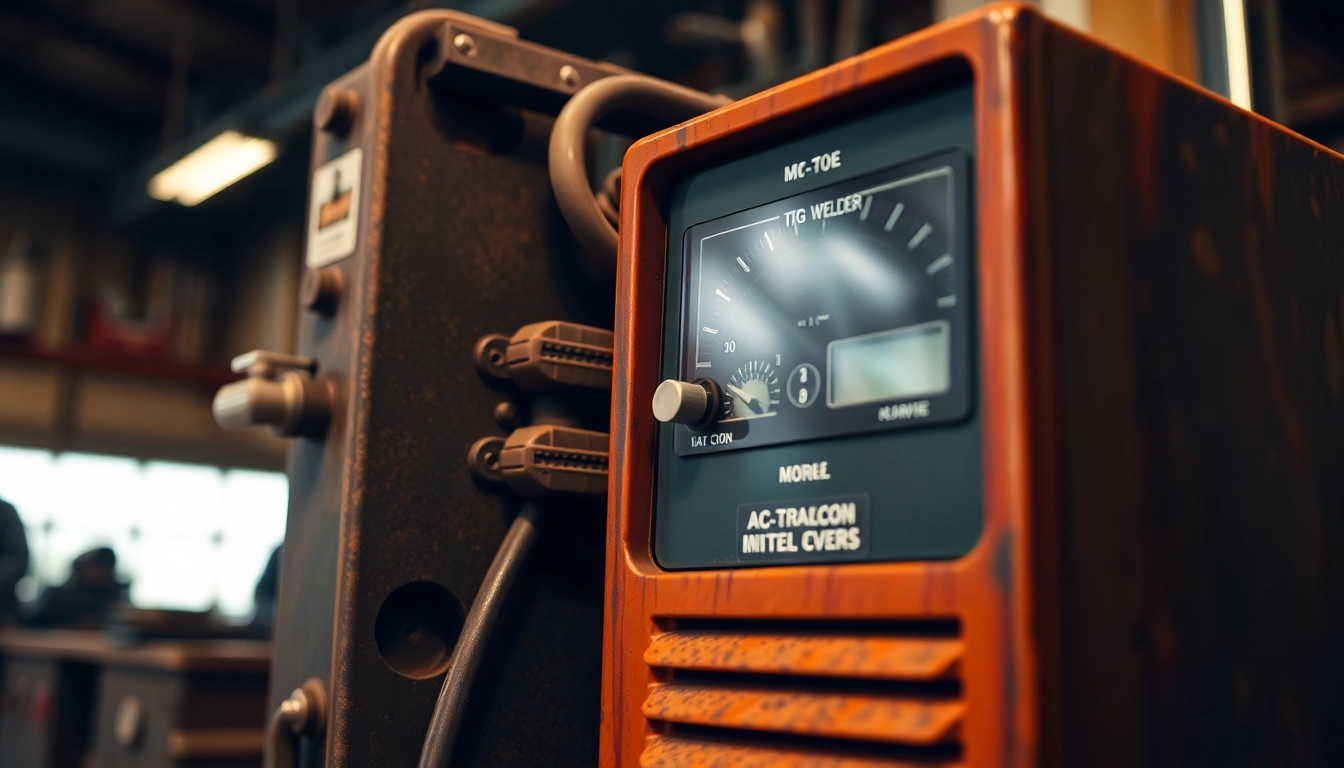Understanding AC DC TIG Welders
1. What is an AC DC TIG Welder?
An AC DC TIG welder, or Tungsten Inert Gas welder, is a specialized welding device that enables welders to join metals like aluminum, stainless steel, and other alloys using two types of electrical current: alternating current (AC) and direct current (DC). The ability to switch between these currents allows welders to tackle a variety of materials and metal thicknesses, enhancing versatility in welding projects. AC is particularly useful for welding aluminum, as it helps to clean the material by breaking down the oxide layer that typically forms on its surface. In contrast, DC is generally preferred for welding stainless steel and carbon steels due to its ability to provide a stable arc and minimize pollution from the tungsten electrode.
2. Advantages of Using AC DC TIG Welding
The use of an ac dc tig welder comes with numerous benefits:
- Versatility: The ability to weld both ferrous and non-ferrous metals broadens the range of possible applications.
- Precision: TIG welding is known for producing clean, precise welds, making it ideal for intricate projects.
- Quality: TIG welding generally offers better quality and aesthetics in the weld bead compared to other welding processes.
- Control: Welders can better control the heat input, which is crucial for thin materials that can be easily warped or burned.
- Less spatter: Unlike MIG welding, TIG produces minimal spatter, resulting in a clean workspace and higher-quality finish.
3. Key Features of AC DC TIG Welders
When selecting an AC DC TIG welder, several critical features should be taken into account:
- Output Range: The output current range is crucial; typically, welders should offer between 10 to 250 amps, depending on the materials being welded.
- Pulsed Arc Function: This feature provides better heat control and can assist in welding thin materials, preventing burn-through.
- Foot Pedal Control: Allowing for hands-free operation, foot pedals enable the welder to adjust the current while moving, enhancing precision.
- Multiple Polarity Settings: Switching between AC and DC polarity should be seamless for various welding tasks.
- Cooling System: An efficient cooling system prolongs the welder’s life, especially during extended periods of use.
Choosing the Right AC DC TIG Welder
1. Factors to Consider When Buying
Choosing the best AC DC TIG welder requires careful consideration of various factors to ensure it meets your specific needs:
- Material Type: Assess the materials you will be welding most frequently. Aluminum requires AC, while stainless steel and mild steel are best with DC.
- Weld Thickness: The thickness of the material dictates which amperage range you will need. For thinner metals, a lower output range is necessary.
- Portability: Consider whether you need a lightweight, portable welder for on-site jobs or if a stationary unit is sufficient.
- Budget: While investing in quality equipment is crucial, availability at multiple price points enables you to find a welder that fits your financial means.
- Performance Ratings: Look for user reviews and expert ratings to gauge reliability and performance feedback from other welders.
2. Best Brands in the Market
Several reputable brands consistently produce high-quality AC DC TIG welders. Here are some of the top brands to consider:
- Miller Electric: Known for its durability and performance, Miller offers a variety of models suitable for beginners and professionals.
- Linde: Linde welding products are known for their innovative features and high build quality, focusing on industrial applications.
- Lincoln Electric: With a long history in the welding industry, Lincoln Electric provides a range of TIG welding machines for different levels of expertise.
- Everlast: A budget-friendly option offering decent quality and performance, Everlast is a favorite among hobbyists and DIY welders.
- PrimeWeld: This emerging brand is gaining popularity for providing advanced technology at competitive pricing.
3. Price Ranges and Budgeting
The price of AC DC TIG welders can vary widely depending on features, quality, and brand. Generally, you can expect:
- Entry-Level Welders: Priced between $200 and $800, these models are often basic but suitable for light to moderate welding tasks.
- Mid-Range Welders: Typically costing from $800 to $2,000, these offer better performance, additional features, and a wider amperage range.
- High-End Welders: For advanced users, industrial-grade models can range from $2,000 to $15,000, providing top-notch features, reliability, and duty cycles.
When budgeting for your welder, don’t forget to include costs for safety gear, consumables, and workshops if you are a beginner.
Operating Your AC DC TIG Welder
1. Safety Precautions to Take
Welding can be hazardous work. It’s vital to observe several safety precautions when operating your AC DC TIG welder:
- Protective Gear: Always wear a welding helmet, gloves, and fire-resistant clothing. Ensure the helmet is equipped with the correct shade to protect your eyes from the UV light.
- Ventilation: Ensure your work area is well-ventilated to prevent inhalation of harmful fumes and gases.
- Clutter-Free Workspace: Maintain a clean work environment free from flammable materials that could ignite during welding.
- Electrical Safety: Be aware of electrical hazards; inspect cables and connections regularly for wear or damage.
2. Setup and Configuration Tips
Correctly setting up your AC DC TIG welder is crucial for optimal performance. Here are some essential tips for configuration:
- Correct Polarity: Choose the appropriate polarity based on the material being welded (AC for aluminum, DC for steel).
- Electrode Selection: Use the right tungsten electrode for your task—green for AC, blue for DC.
- Gas Flow Rate: Set the argon gas flow rate according to your welder’s specifications, typically around 15-20 CFH.
- Amperage Settings: Adjust the amps based on material thickness; more current for thicker materials, less for thinner ones.
3. Maintaining Optimal Performance
Maintaining your AC DC TIG welder ensures longevity and consistent performance. Follow these best practices:
- Regular Cleaning: Clean the torch, collet, and cups regularly to prevent contamination and maintain the quality of welds.
- Inspect Cables: Frequently check leads and cables for fraying and damage, as faulty cables can pose safety hazards.
- Check Gas Levels: Always ensure you have enough shielding gas to avoid weld contamination.
- Stored Properly: Keep the welder stored in a dry, cool place to prevent moisture accumulation or rust on components.
Common Applications for AC DC TIG Welding
1. Welding Aluminum vs. Steel
Different materials respond differently to welding techniques, and the choice of AC DC TIG welding is essential:
Welding Aluminum
Aluminum welding usually requires AC because it cleans the oxide layer on the surface. The AC current helps prevent the build-up of heat, which is particularly important for working with thinner materials.
Welding Steel
When welding steel, the use of DC current offers greater stability and better penetration, suitable for various thicknesses and steel types like stainless steel or low alloy.
2. Industries That Benefit from AC DC TIG Welding
AC DC TIG welding is utilized across a variety of industries, including:
- Aerospace: High precision and quality welds are critical, making TIG welding indispensable in this sector.
- Automotive: From bodies to frames, the clean finishes and fine detail offered by TIG welding are extremely beneficial.
- Manufacturing: Many tools and equipment require custom components that often necessitate the use of TIG welding techniques.
- Medical: In items like surgical instruments and other medical equipment where cleanliness and precision are paramount, TIG provides an ideal solution.
3. Case Studies: Successful Projects
Here are a few examples of successful projects that utilized AC DC TIG welding:
- Airplane Wing Fabrication: The aerospace industry relies heavily on AC DC TIG welding to fabricate fuel-efficient airplane wings with high-performance criteria.
- Custom Automotive Builds: Custom shops often use TIG welding for high-performance vehicles where aesthetics and strength are equally important.
- Medical Device Manufacturing: Manufacturers have employed AC DC TIG welding to create complex geometries in surgical instruments.
Troubleshooting Common Issues with AC DC TIG Welders
1. Identifying Welding Problems
Even experienced welders face challenges. Recognizing common problems is a key step in troubleshooting:
- Inconsistent Arc: This could indicate improper settings, a faulty cable, or poor electrode condition.
- Poor Penetration: Typically caused by too low of a current setting for the material thickness being welded.
- Excessive Spatter: Indicating poor gas coverage, this issue can arise from incorrect gas settings or flow rates.
2. Solutions for Frequent Malfunctions
Resolving common welding issues often involves simple adjustments or troubleshooting:
- Adjust Settings: If your arc is inconsistent or shaky, check the current, speed, and type of electrode.
- Maintain Equipment: Regularly check and replace worn electrodes and ensure all connections are tight and free of damage.
- Gas Issues: Adjust the gas flow if spatter occurs, ensuring that the gas covers the weld area adequately during the welding process.
3. Upgrading Your Equipment
As technology advances, so should your tools. Consider these points when upgrading:
- Technological Improvements: Newer models often come with enhancements like digital displays, better arc stability, or automated systems.
- Increased Amperage: If you frequently work with thicker materials, it may be worth investing in a machine with higher amperage capabilities.
- Better Portability: Evaluate whether an inverter-style machine would suit your needs better, especially for fieldwork.



